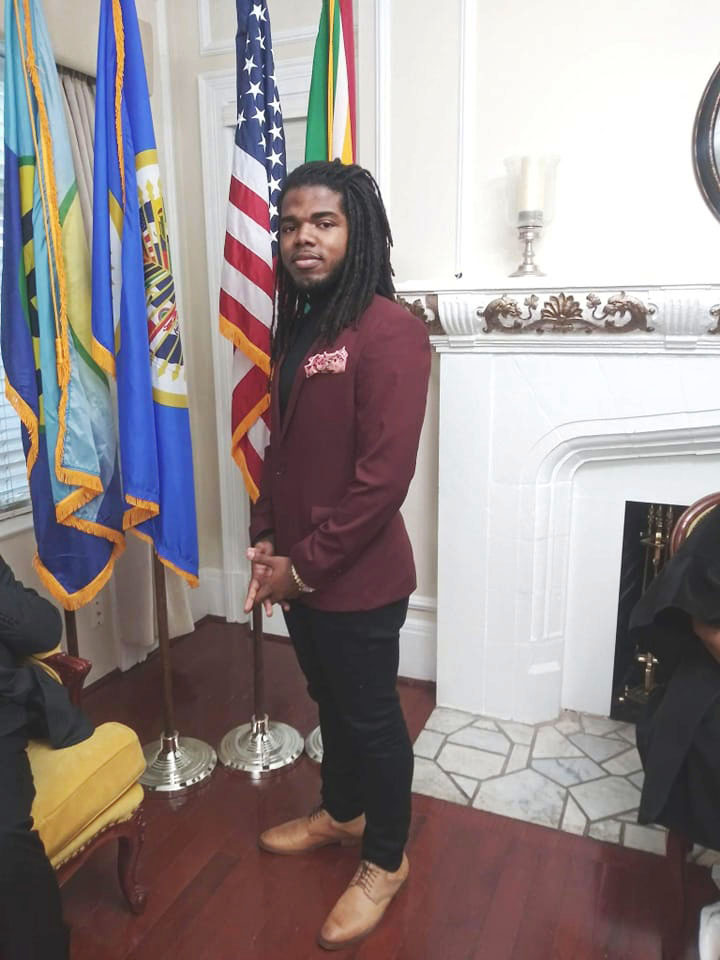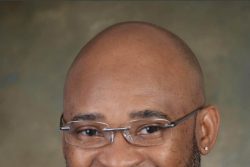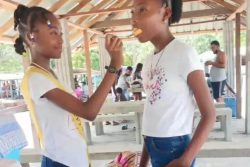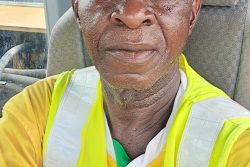“Guyana has me in a chokehold,” Shaphan Hestick, the second place winner of the Guyana Prize for Literature 2023 in Drama said. “No matter the creative project or process, once I am working on it, it becomes Guyanese.”
Hestick grew up on the West Coast Demerara and spent his childhood biking through the villages near Ruimzeight and raiding the Jamoon tree behind his church. “From being immersed in Guyanese culture and relating so closely to real-life Guyanese characters, I’ve begun – for better or worse – to associate specific personalities with Guyanese language patterns, mannerisms, and motivations,” he said.
In Hestick’s first production, “With a Kiss” (his prize-winning play) the main character, Judas, “was a guarded and secretive persona, who was obsessed with control; controlling the way he was perceived, controlling his family’s finances and reputation, and controlling the narrative around Jesus,” Hestick explained. “Antonio, on the other hand, I wrote to be the complete opposite. He is a free-spirited, open charmer, who is in touch with current events and public opinion. His beliefs are radical and he has no reservations about expressing them. And so he is the character who slipped most into Creolese, and had the most Caribbean mannerisms.

He explained that Guyanese culture and history features heavily in his writing, leaving him with “the narrative of social justice, and the realities of oppressed people.”
Hestick said the play wrote itself and he found the concept so creatively compelling that there was not much struggle seeing it to its completion. He did a lot of research about the Jewish community during the period of Jesus’ death and found that they had to endure much persecution and abuse. He said their subjugation to this resonated with him.
The play primarily deals with Jesus’ crucifixion but from the point-of-view of Judas Iscariot.
“I spent most of my time considering the details of each scene, the relationships between the characters, and their evolution as events unfolded. The characters took on their own personalities as the story developed, and it became easier to intuit what one character would say or do in a particular circumstance,” Hestick explained.
 Hestick also saw the value of receiving feedback and described himself as a novice writer.
Hestick also saw the value of receiving feedback and described himself as a novice writer.
“I found this to be the most difficult part. I had no problem with hearing that my work needed improvement. Even as a creative, I’m well aware that every medium has conventions, and drama has many that I was and am unaware of. I did, however, need to adjudicate the nature of the changes I’d make to my story. Some recommendations I saw a great deal of wisdom in, as I believed they contributed significantly to enhancing the sincerity of my work. Others I discarded as differences in opinion and preference,” he said.
Christianity plays a big part in Hestick’s life and he explained that his faith, like his culture, is interwoven into his art. He said that his character designs are subordinate to his personal beliefs. “The first set of decisions I make in my creative process involve the degree to which my faith and culture will be involved. I craft every piece of work I produce with a message and intention,” he stated. “I begin with the story I want to tell, the emotions I hope this story would invoke, and the influence I hope the story would have on my readers. Once those details have been finalised, the minutiae of characterisation can be dealt with.”
Hestick especially believes in the power of art as a tool for social change. He said that paintings, murals, and sculptures can highlight social issues like climate change, deforestation, and indigenous rights which can spark conversations. Similarly, “theatre, dance and music can tell stories that resonate with people’s experiences, helping to raise awareness about social injustices and environmental issues. Promoting indigenous and traditional arts helps preserve Guyana’s rich cultural heritage. This can foster a sense of identity and pride, which is crucial for social cohesion,” Hestick was keen to point out.
He said Guyana has experienced a great loss of history and culture due to chronic lack of investment in the performing and visual arts, mediums that are key to transmitting stories across generations. “The absence of adequate funding and support for these artistic expressions has led to the erosion of cultural heritage and traditions that once thrived within communities. This neglect not only hampers the preservation of indigenous and local narratives but also stifles the creative voices that could otherwise foster a deeper understanding and appreciation of the nation’s rich and diverse history,” Hestick stressed.
On the issue of using art as a tool to bridge the divide of culture and religion, Hestick said he did not see it as his job and this divide would be bridged by people who want to cross it.
“I don’t see it as my responsibility as a creative to produce art that heals social rifts. I make sure that my creative output is ethical and that I remain responsible and conscientious with my platform,” he said. “I have also seen that art can be taken wildly out of context by people committed to gatekeeping the process of social healing and change. So, while I am optimistic about the impact art can have, I generally do not pressure myself to save the world through my work.”
While not pressuring himself, Hestick’s faith plays a critical role in what he hopes to achieve through his art. “I believe that in good spirit, relationships can be healed, and that anyone, regardless of where they come from, or what has happened in their past, can aspire to become a better version of themselves through the power of God,” he said. “My faith gives me hope, and I try to incorporate this message into my work as much as possible.”
He also highlighted some of the practical steps his church has taken for community development. “My church has supported families in building their homes, replaced vehicles for church members who’ve been in accidents, sponsored remedial and tertiary education for young people, recruited volunteers to host lessons for CSEC exam students, hosted performing arts workshops, given youths opportunities to volunteer in audiovisual media production, and financed multiple theatre and music productions,” he said. “Religion is impactful when people subscribe to religious belief and values. Religion, like art, brings consenting people together. Aside from the fact that several of our largest cultural celebrations are centred around religious holidays, it is no mere coincidence that the most successful Guyanese musical artiste of our generation is a gospel singer, who has accolades within and without the church. Religious cultural celebrations reinforce our cultural appreciation and heritage and religious institutions instil a sense of values into Guyanese communities.”
In addition to writing for theatre, Hestick is a member of a band named Frontier Worship, where he acts as a singer/songwriter. He frequently hosts events at the Vreed-en-Hoop Wesleyan Church and welcomes community members to join. Between this and the production of “With a Kiss”, a number of young people have come forward to say that the work of his team touched them personally, Hestick said.
“Many young people looking for opportunities for creative expression find such opportunities at our church. Additionally, because we locate our work within an institution trusted by our community, we are able to maintain a safe working environment. For me, that is the most meaningful impact that my work can have,” he stated.
Hestick said he never aspired to become creative, but the culture of youths engaging in performing arts is an integral part of his church experience. The arts also are not a means to get a message and creative expression out.
“It has become important to me to use the performing arts as a means of raising funds for community development. Through theatrical productions, musical performances, and other artistic endeavours, I aim to bring people together not only to experience the power of art but also to support vital community initiatives,” Hestick stated. “By channelling the proceeds from these events into projects that enhance local infrastructure, education, and social services, I hope to make a tangible difference in the lives of those around me. This approach allows art to transcend entertainment, becoming a catalyst for positive change and community empowerment.”
Storytelling, critical to exploring Hestick’s community, has become of great value to his personal life. “As a student of energy policy at George Washington University, I’ve been trained to synthesise data into stories about the human experience. For example, data about power outage frequencies in a city can tell a story of the average resident’s quality of life, the compounded costs of equipment damaged by power surges, the difficulty of getting children to study or do homework without light, and so on,” he said.
Hestick’s next project is a gospel album, the single for which he will be releasing soon. “The songs on this album carry a distinct message of hope, and there are even songs that speak to social issues. The message of salvation and hope in the gospel is something I think many people need to hear today. As our understanding of mental health improves and people become more aware of their own personal issues, I aspire to create art that would encourage introspection towards healing,” he expressed.
Hestick’s short film “Into the Room” will also soon have its premiere at the Georgetown Film Festival, which produced the project. It is a silent thriller/horror film about domestic violence and child abuse. This film will be screened at the Theatre Guild on August 23rd with a number of other films.






